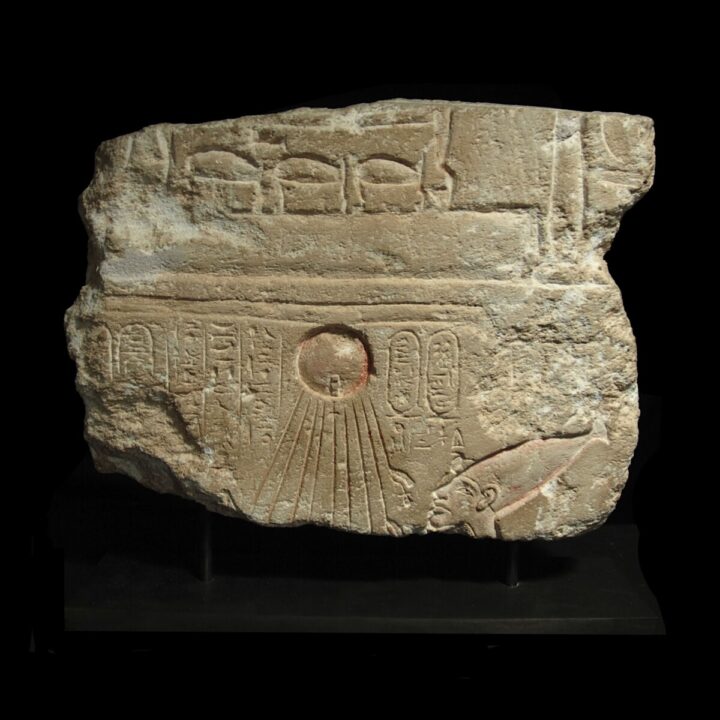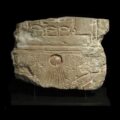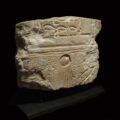Historically Important Amarna Relief with Akhenaten from the Sunshade Chapel of Tutankhamun
Culture: Egyptian
Period: New Kingdom, 18th dynasty, Reign of Akhenaten, 1340-1339 B.C.
Material: Limestone
Dimensions: 26 cm x 19.2 cm
Price: 125 000 Euro
Ref: 1572
Provenance: In 1965 exhibited in “Ägyptische Kunst aus der Zeit des Königs Echnaton” in the Museum für Kunst und Gewerbe in Hamburg, Germany. Published in the catalogue of the same name, p. 15, no. 5, fig. 24. Thence auctioned with Christie’s London on 24 February 1970, lot 82. Thence with Galerie Puhze Germany, acquired prior to 2001. On 31 October 2001 acquired by the German Egyptologist Hermann A. Schlögl and published numerous times. Amongst others: H. A. Schlögl and A. Grimm “Das thebanische Grab Nr. 136 und der Beginn der Amarnazeit”, Wiesbaden 2005, p. 37, fig. XLVIII. H. A. Schlögl “Echnaton”, Munich 2008, p. 31 (C.H. Beck Verlag). H. A. Schlögl and R. Buxtorf “Kunst und Handwerk aus Ägyptens Goldener Zeit”, Wiesbaden 2018, p. 56f. As well as H. A. Schlögl “Das Alte Ägypten”, Munich 2022, p. 237. Additionally mentioned in: Karin Schlott “Streit um Tutanchamun”, in: Spektrum der Wissenschaft vom 29 November 2012. With an Art Loss Register excerpt of 10 October 2001.
Condition: Unrestored
Description: Since the discovery of the tomb of the young Pharaoh Tutankhamun in 1922, there has been speculation about who his parents might be. When the present relief emerged 43 years later for the first time in the exhibition “Ägyptische Kunst aus der Zeit des Königs Echnaton” in the Museum für Kunst und Gewerbe in Hamburg it has become a milestone for researchers. The relief depicts the head of pharaoh Akhenaten with the crown of Upper Egypt in prayer gesture in front of the sun disk of his God Aten. Rays radiate from the red-coloured sun and end in small hands. One of the hands holds the ankh symbol in front of the pharaoh’s face. More importantly than this testimony of the first monotheism in mankind’s history is the hieroglyphic inscription in vertical columns. It is a prayer, the translation reads: “Great living Aten, who is in his jubilees, Lord of all that the sun disk encloses, Lord of the sky, Lord of the earth in the sunshade chapel of the BIOLOGICAL King's son Tutankhaten in Akhetaten.” The relief therefore originates from the sunshade chapel of Tutankhaten, who had to return to Thebes and changed his name to Tutankhamun after his father’s passing. Akhenaten had built chapels like this only for his closest family members in his capital city Amarna. This made clear: Tutankhamun was Akhenaten’s son. The final proof was delivered by a DNA test in 2010. This widely published relief is the first evidence of the family relationship between two of the most important pharaohs in Egyptian history. Mounted.





